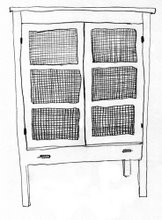
These were the days when 20 cents would buy you a good-sized bag of lollies to munch away on during the afternoon: white chocolate whirls, caramel-filled mates, whizzy rainbow sherbets, raspberries, milk bottles and bananas. We'd linger over the selection, choosing as wide a selection as possible to go into the white paper bag that the shopkeeper would finish off with a slight twist at the top.
If we were ever given - or found on the ground - 50 cents ... well, that was a special treat! It bought you a big fat bag of lollies that could keep you going for a day or two. I loved going to the local shop, where the glass cabinet, conveniently located at the height of a child's eyes, was filled with small cardboard boxes of different lollies, some costing 1 cent each and others 2 cents. Am I showing my age? This was only the 1980s - doesn't feel so long ago to me!
Alas, many corner shops and milk bars have disappeared, put out of business by big open-nearly-all-hours supermarkets and convenience stores. Lollies appear to be one of the five food groups for most children now, rather than a special treat. But the demise of the milk bar has meant there are now some specialist lolly shops that cater to old-fashioned tastes instead: Sweet Port in Port Melbourne, Brighton Chocolates, the Williamstown Chocolate Shop, the Old Village Lolly Shop in Yarraville and the Original Lolly Store in Carlton. And, tucked away in a nondescript shopping strip in Melbourne Rd, Newport, situated among a maternity shop, a pet store, a Thai takeaway and the local vet, is Snowballs Ice Cream & Lollies shop.
This shop is crammed full of every type and sort of lolly you could wish for, especially old-fashioned lollies that are difficult to find: spearmint leaves, chocolate rock, speckles, sour dummies, wine gums, bananas, strawberries and cream, raspberries, chicos, pineapples, jelly babies, snakes, dark and milk chocolate bullets, white raspberry bullets, Newman's dark and milk chocolate ginger, peppermints, Belgian milk and dark chocolate couverture chocolate chips, Wizz Fizz, zombie bars, raspberry licorice straps, blocks of European chocolate, Cocoa Farm wine chocolates, Pink Lady chocolates, licorice all-sorts, striped lolly-pops, boiled lollies, fudge, humbugs, rocky road, coconut roughs and cherry bites. There's also Norgen-Vaaz ice-cream and you can order ice-cream cakes.
Every available surface in this shop is crammed with lollies and sweet treats and I found myself lost in nostalgia as I found many lollies I hadn't seen for years. I also find this shop very useful for sourcing lollies to decorate birthday cakes. Every year, like my mother did for me, I make my children's birthday cakes from the classic Australian Women's Weekly birthday cakes book, which has quite specific requirements in what lollies it uses to decorate and create masterpieces. My local supermarket has an increasingly restricted range - can you believe I couldn't find spearmint leaves there when I looked last week? - and I never have a problem sourcing what I need from Snowballs. It's good to have such a treasure on my doorstep.
Snowballs Ice Creams & Lollies, 320 Melbourne Road, Newport










